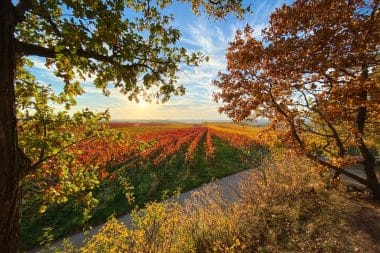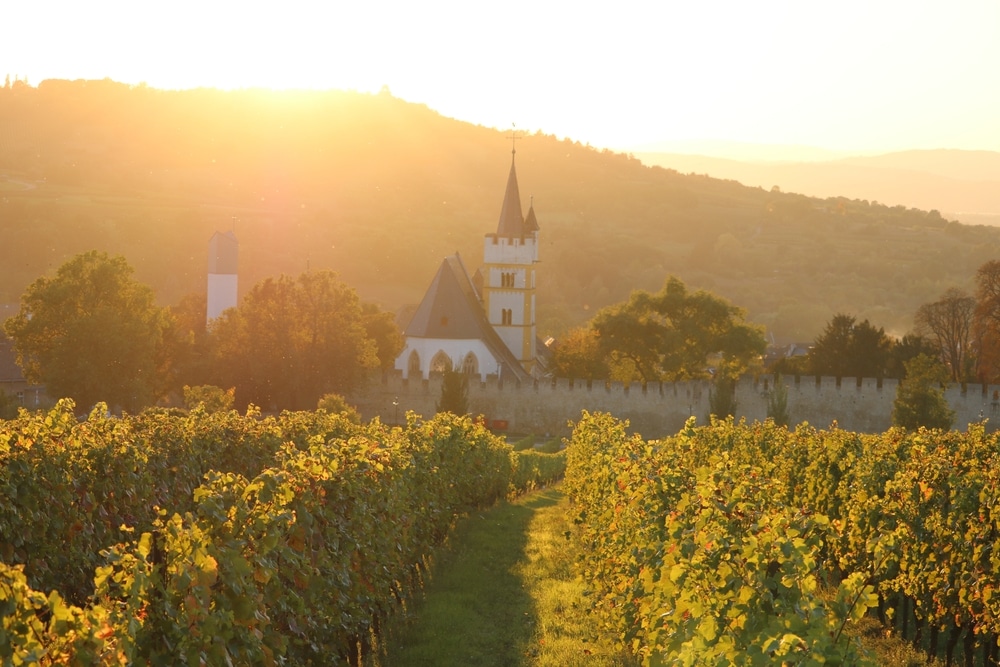Hiking not only brings health benefits, but also the opportunity to experience the beauty of nature directly. Hiking and pilgrimage trails in particular offer an escape from everyday life and make it possible to let the mind come to rest. Even in the depths of the Middle Ages, Rheinhessen was a stopover for adventurous pilgrims on their way to Santiago de Compostela. Today there are several Camino de Santiago routes that run through an enchanting nature with rolling hills and vineyards. The region is known for its excellent white wines, especially the Rheinhessen Riesling. The Rhine-Hessian Ways of St. James extend over about 200 kilometers and offer varied routes through this beautiful area. On the hiking tours, you can walk along idyllically situated rivers such as the Rhine or Selz and pass picturesque villages.
Below we present a selection of the most beautiful Ways of St. James in Rheinhessen:
From Worms to Metz: The heavenly monastery route
The Worms-Metz monastery route is a historic trade route of the Celts and Romans, lined with monasteries and churches. It takes visitors on an exciting journey through ancient trade routes and religious sites. With its historical highlights and scenic beauty, it is a worthwhile adventure for hikers and history buffs. One can easily find the trail as it is marked with yellow arrows and the European shell. There are two variants: the northern span and the southern span.
Long route Nordspange (intermediate route):
The northern span consists of a total of four sections. The first section stretches over about 21 km from Worms to Harxheim im Zellertal. The starting point is the south portal of the cathedral. There are some highlights to discover on this route, including the Luther monument, the bird trail in Monsheim and the pilgrimage church of Saint Philip in Zell.
The second section leads about 21 km from Harxheim to Steinbach am Donnersberg. On the way, you will pass the oldest sacred building in the Palatinate in Bubenheim and the former Münsterdreisen monastery. Particularly interesting is also the youth hostel with the adjacent Celtic village, where you can gain insights into old Celtic settlements.
The third stage leads about 20 km from Steinbach to Otterberg. The highlights of this route include the mining village of Irmsbach, the Kaiserstraße in Alsenbrück as well as the Rochus Chapel in Schallodenbach and the former cistern church in Otterberg.
The longest section is the fourth part from Otterberg to Landstuhl with a length of 32 km. Above the town of Landstuhl towers the impressive Nanstein Castle as the absolute highlight of this route. Also worth a visit is the town church, built between 1862 and 1863. The larger route of the northern span finally ends in Landstuhl, where it meets the northern route of the Palatinate Way of St. James, which continues to France .
Short route Südspange (moderately difficult route):
The smaller route of about 79 km leads from Worms via Harxheim, Eiswoog, Kaiserslautern to Gelterswoog. We start at the south portal of the cathedral in Worms, one of the most important Romanesque churches in Germany , and walk towards the Pfrimm, a tributary of the Rhine. The path leads along the course of the stream to the Zell panorama trail and then on to the vineyards to Harxheim. On the way, it is possible to walk through the centre of Monsheim or walk past it.
Passing the former Ramosa Monastery, a cistern monastery from the 12th century, we reach the picturesque Eiswoog reservoir, where you can hike along a stream, the Alsenz spring. Finally, we turn off on the route in the direction of Kaiserslautern. One of the last highlights before reaching the destination is the Rochus Chapel from the 15th century. As soon as you reach the Gelterswoog reservoir, which was built in the 18th century, you meet the northern route from Speyer to Hornbach.
From Zell to Standenbühl: An adventurous pilgrimage
The Jakobs-Pilgerweg from Zell to Standenbühl is a varied route that offers numerous historical and cultural attractions. The section between Zell and Standenbühl stretches for about 22 kilometres and is part of the monastery route from Worms to Metz. It begins in the pilgrimage church of St. Philip in Zell, a Romanesque basilica from the 12th century.
From there it leads through Harxheim, where you can visit the oldest religious building in the Palatinate, the village church of St. Peter from 1060 in Bubenheim, to Steinbach am Donnersberg, where you can marvel at the Celtic village and the Celtic garden on the highest mountain in the Palatinate. Then continue to Otterberg, with a stop at the 13th-century Cistercian church, which is one of the largest Gothic churches in Rhineland-Palatinate. This eventful stage ends in Standenbühl.
From Steinbach to Wartenberg-Rohrbach: A path full of surprises

The Way of St. James from Steinbach am Donnersberg to Wartenberg-Rohrbach is also part of the Worms-Metz Monastery Route, which connects Rhenish Hesse, Palatinate, Saarland and Lorraine. On this 14 km long and easy route, hikers pass some interesting places. For example, at the Hahnweilerhof in Börrstadt, which belongs to the local municipality of Börrstadt. In Imsbach, it is worth taking a detour to the Mining Museum to see exciting exhibits. Then it continues through the Winnweiler district of Alsenbrück and finally to Lohnsfeld to Rohrbach.
Here you can experience the ups and downs of the Palatinate Forest, the extensive and fertile landscape of the Zeller Valley, the peaceful silence of the Eiswoog and the rich heritage of the historic villages and churches to the fullest. The landscape along this route is characterized by a mixture of forests, meadows, fields, vineyards, streams and lakes. Here there are numerous opportunities to observe the flora and fauna as well as to relax the soul.
Our book tip: Ways of St. James Rheinhessen – Hiking on historic pilgrimage paths
If you would like to learn more about the hiking trails in Germany’s largest wine-growing region, we recommend the travel guide “Jakobswege Rheinhessen” by Frank Hamm, published by Peter Meyer Verlag (ISBN 978-3-89859-336-6).
The book offers hiking information for 17 tours: 8 comfortable stages of the Way of St. James from Mainz via Bingen to Worms, 2 alternative routes near Wörrstadt and 7 circular routes as local loops. In addition, the reader receives culinary recommendations, accommodation options, precise maps with GPX data and information on the pilgrim stamp stations.
My book “Ways of St. James Rheinhessen” is a tribute to my homeland and its cultural history and diversity. In addition to detailed tour descriptions and tips, I give an overview of the development of the region from millions of years ago to the present day. In short essays, the reader learns background information such as the difference between Gutsschänke and Strausswirtschaft, what Heidenturm churches are and why pilgrims did not travel by ship and what simultaneous churches are.In the footsteps of pilgrims, I explored cities, villages, hills and valleys of Rheinhessen and learned a lot of new things about my homeland.
Content:
The Way of St. James begins in Rheinhessen on the doorstep. For those who want to make a pilgrimage to themselves, but don’t want to travel to Spain first, a new travel guide from Peter Meyer Verlag in Saulheim offers valuable knowledge and practical tips.
As early as the Middle Ages, Rheinhessen was a transit station for pilgrims with the remote destination of Santiago de Compostela. In his hiking guide, author Frank Hamm invites pilgrims and all those who want to become one to explore the local vineyard landscape with its many idyllic villages.
Here the Way of St. James connects the city triangle Mainz – Bingen – Worms. Roman excavations, castles and old village churches document the rich heritage of this ancient cultural landscape. In 17 stage and round trips, the approximately 200 kilometres of the
Rhine-Hessian Ways of St. James with photos, route maps and altitude profiles. The handily cut stages offer plenty of opportunity for inner and culinary contemplation with picturesque views.
Pilgrims and day hikers receive sufficient practical information. Accommodation, shopping and refreshment stops can be looked up in the book, as well as the arrival and departure by train and bus. The book “Ways of St. James Rheinhessen” inspires people to get to know their homeland on foot – in an environmentally friendly way and in a new way
Because of.
The sustainably produced travel guide combines handiness with extensive information and is available in bookstores for 22 euros.


